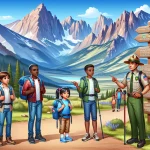The Comanche Tribes, a key Native American tribe in the United States, have played a significant role in shaping Colorado’s history and cultural landscape. As one of the most influential indigenous groups in the Great Plains, the Comanche has left an indelible mark on the state’s rich tapestry of life and learning. This article explores the unique position of the Comanche Tribes within Colorado, their historical interactions with other Native American tribes, and their ongoing efforts to preserve their heritage and rights in the context of American Indian affairs.
In This Article
TL;DR
- The Comanche Tribes are deeply connected to the Colorado landscape, including Durango, Pagosa Springs, and the Rio Grande.
- The Comanche have a complex history of alliances and conflicts with other indigenous groups in Colorado, such as the Ute, Shoshone, Kiowa, Navajo, Cheyenne, and Arapaho.
- The Comanche Tribes face modern challenges related to reservations, land rights, and cultural preservation but continue to work towards education and economic development within their communities.
The Mesa Verde Cliff Dwellings: A Testament to Comanche History
The Mesa Verde Cliff Dwellings, now a National Park in Colorado, stand as a testament to the historical significance of the Comanche Tribes in the United States. These ancient dwellings, built by the Pueblo people, have a deep connection to the Comanche, a prominent Plains Indian tribe who have interacted with the Pueblo and other indigenous groups in the region for centuries. The history of the Comanche Tribes, often referred to as the Comanche Nation or Comanche people, is intricately woven into the fabric of these cliff dwellings, offering a unique perspective on their cultural practices and historical interactions with Southwest Indian communities across the Southern Plains, including the Great Plains and Llano Estacado areas.
Native Tribes of Colorado and Their Interactions
The Comanche Tribes have had a complex relationship with other Native American tribes in Colorado, including the Ute, Shoshone, Kiowa, Navajo, Cheyenne, and Arapaho. These interactions have shaped the cultural and social dynamics of the region, with alliances and conflicts defining the historical landscape. In 1977, a symbolic end to the enmity between the Ute and Comanche was marked, highlighting the evolving nature of these relationships. Indigenous treaties have also played a crucial role in shaping the landscape of Colorado and the lives of its native inhabitants, influencing Indian affairs throughout North America.
Indigenous Rights and Leadership
Indigenous rights activists and tribal leaders have advocated for the rights and sovereignty of the Comanche Tribes and other indigenous groups in Colorado. These leaders, including figures like Chief Quanah Parker, a renowned Comanche leader and son of Cynthia Ann Parker, have worked tirelessly to preserve the heritage and rights of their communities. They fight to recognize unfulfilled treaties and protect their cultural practices, such as the Comanche language and Comanche clothing traditions. Their efforts have been instrumental in ensuring that the voices of the Comanche and other Native American peoples are heard and respected across the United States.
Cultural Practices and Traditions
The Comanche Tribes have a rich tapestry of cultural practices and traditions passed down through generations. These include tanning skills, the Sun Dance, Animal Dance, basket weaving, and quillwork. These practices are deeply ingrained in the daily life and spiritual beliefs of the Comanche, serving as a vital link to their ancestral heritage in the Southwest Oklahoma and Eastern New Mexico regions. The preservation and transmission of these traditions remain a priority for contemporary Comanche society, as they form an integral part of their cultural identity and continue to define the Comanche culture in the broader context of Native American tribes.
The Role of Bison Hunting in Comanche Life
Bison hunting has been a central aspect of Comanche life, crucial to their survival, culture, and economy. The techniques, rituals, and social structures surrounding bison hunting have shaped the relationships between the Comanche Tribes and neighboring indigenous groups, as well as with settlers and the U.S. government. The importance of bison hunting in Comanche history cannot be overstated, as it has profoundly impacted their way of life and interactions with the world around them.
Comanche Tribes and the Colorado Landscape
The Comanche Tribes have a deep connection to specific locations in Colorado, such as Durango, Pagosa Springs, and the Rio Grande. These areas hold great significance in the Comanche’s historical and contemporary lives, with natural features and resources, such as bison, influencing their lifestyle, migrations, and conflicts with European settlers and other Plains tribes.
The Colorado landscape is intricately tied to the identity and experiences of the Comanche Tribes, shaping their relationship with the land and its inhabitants across the Great Plains and Southern Plains. This connection extends to their interactions with other Native American tribes and European American settlers, reflecting a complex web of alliances and conflicts that define the historical landscape of the Southwest United States.
Modern Challenges and Reservations
Today, the Comanche Tribes face various contemporary challenges, including reservations, land rights, and cultural preservation. The current status of reservations in Colorado has a significant impact on the Comanche Tribes and other indigenous communities as they navigate the complexities of maintaining their traditional way of life while adapting to modern realities. Efforts towards cultural preservation, education, and economic development within the Comanche Tribes and the broader indigenous community in Colorado are ongoing as they work to ensure a vibrant future for their people.
FAQ
What is the historical significance of the Mesa Verde Cliff Dwellings to the Comanche Tribes?
The Mesa Verde Cliff Dwellings, built by the Pueblo people, have a deep connection to the Comanche Tribes, who have interacted with the Pueblo and other indigenous groups in the region for centuries. These dwellings offer a unique perspective on the cultural practices and historical interactions of the Comanche.
How have indigenous treaties shaped the landscape of Colorado and the lives of the Comanche Tribes?
Indigenous treaties have played a crucial role in shaping the landscape of Colorado and the lives of its native inhabitants, including the Comanche Tribes. These treaties have defined the relationships between indigenous groups and the U.S. government, impacting land rights, cultural practices, and the overall experiences of the Comanche and other tribes.
What are some of the cultural practices and traditions of the Comanche Tribes?
The Comanche Tribes have a rich tapestry of cultural practices and traditions, including tanning skills, the Sun Dance, Animal Dance, basket weaving, and quillwork. These practices are deeply ingrained in the daComanche’s daily livesnd spiritual beliefs ofd serve as a vital link to their ancestral heritage.
How has bison hunting influenced the lives of the Comanche Tribes?
Bison hunting has been a central aspect of Comanche life, crucial to their survival, culture, and economy. The techniques, rituals, and social structures surrounding bison hunting have shaped the relationships between the Comanche Tribes and neighboring indigenous groups, as well as with settlers and the U.S. government.
What modern challenges do the Comanche Tribes face in Colorado?
The Comanche Tribes face various contemporary challenges, including issues related to reservations, land rights, and cultural preservation. They navigate the complexities of maintaining their traditional way of life while adapting to modern realities and working towards cultural preservation, education, and economic development within their communities.






